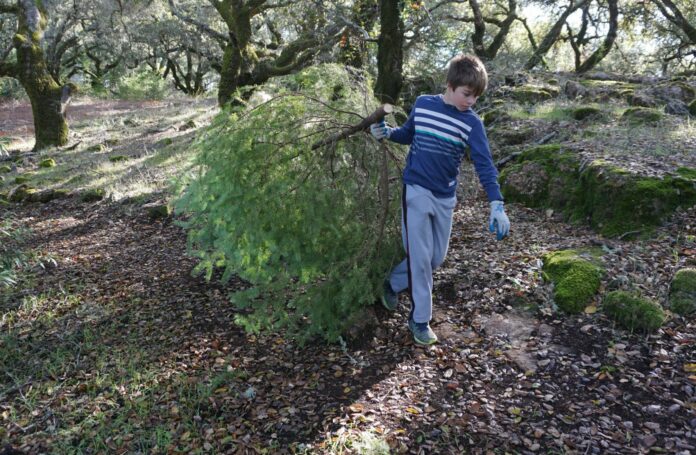Not many families wade through heavily wooded forests anymore to find that perfect Christmas tree — save for the Griswolds in the “Christmas Vacation” film. Most just go to their local neighborhood tree lots.
However, this holiday season, LandPaths has once again opened two of its preserves — Ocean Song Preserve in Occidental and at the Riddell Preserve in Healdsburg — for Christmas tree harvesting, a fun family activity that doubles as fire fuel reduction.
During the harvesting outings, participants can cut down and take as many Douglas fir trees as they like, however it requires a bit of a hike and the strength to saw down and lug out your own tree.
According to LandPaths Preserve Stewardship Lead Erin Mulligan, the free event started around 2014 or 2015 when LandPaths workers started seeing a large influx of Douglas Fir trees into the oak woodland at the Riddell Preserve.
The idea to start Christmas tree harvesting began one day while a group was working on removing the firs.
“We were removing them with a group of volunteers, and one of them said, ‘Gee, I am going to take one for a Christmas tree,’” Mulligan said.
The event has been popular ever since, often filling up with sign-ups weeks before the harvesting outings are even scheduled. (This year’s Christmas tree harvest is already fully booked at both sites.)
Mulligan estimates that around 90 people hike out with LandPaths each year to pick out a tree. She said around 200 to 300 trees are harvested each year.
How does fir harvesting help to the surrounding environment?
Mulligan said there are three significant benefits to thinning Douglas firs: fire fuel management; maintaining oak woodland health; and promoting biodiversity.
Fire fuel management
“Fire fuel reduction is an element of this,” Mulligan said.
She said Douglas firs can be dangerous during fires. They’re thin, tall and dense, providing perfect “ladder fuel.”
Ladder fuel is a firefighting term for vegetation that allows a fire to climb up from the forest floor into the tree canopy.
“Ladder fuels can make a ground fire into a canopy fire,” Mulligan said
She said older trees catch easier, and once a fire is up in a canopy of older trees, it can spread rapidly.
Firs also create dangerous fire conditions because they grow in dense clusters.
“Hundreds of them can be within a hundred square meters,” Mulligan said.
Oak woodland protection
Mulligan said that tree thinning occurred regularly hundreds of years ago when indigenous peoples conducted burns throughout the woodland landscape.
They were “burning land for many years. It kept the oak woodlands healthy,” Mulligan said, noting that this practice also helped remove certain tree species that may have been crowding other plants.
“What we’ve seen in the last 100 years, when the burning stopped, was in an influx of Douglas firs.”
She said once firs take over in an oak woodland area, it can be difficult for oaks to survive in the shady conditions that the towering and dense firs can create.
“Oak needs full, natural light … the firs can block the light and kill them,” she said.
Consequently, thinning the firs can make healthier living conditions for native oak trees.
Protecting biodiversity
Mulligan said one of the biggest goals of the Christmas tree harvesting program is creating biodiversity.
“We want to see fir and oak at Riddell, but there is a higher percentage of firs,” Mulligan said.
“We want to protect oak,” she said, noting that oaks provide important habitat for local flora and fauna.
Other benefits
The Christmas tree harvest also helps with trail maintenance and woodland upkeep.
Mulligan said the fir thinning has been helpful for keeping a recently added hiking trail at Riddell clear from any overgrowth.
She said it also helps with aesthetics.
“For anyone who comes out here, you can see only a thick understory layer (of fir trees). When you remove these, it is amazing the transformation the forest takes,” Mulligan said.
Removing the firs allows people who visit the preserve a chance to see into the forest and admire the many native plants and shrubbery that Douglas firs crowd out.
For more information about LandPaths and their work visit: landpaths.org.








